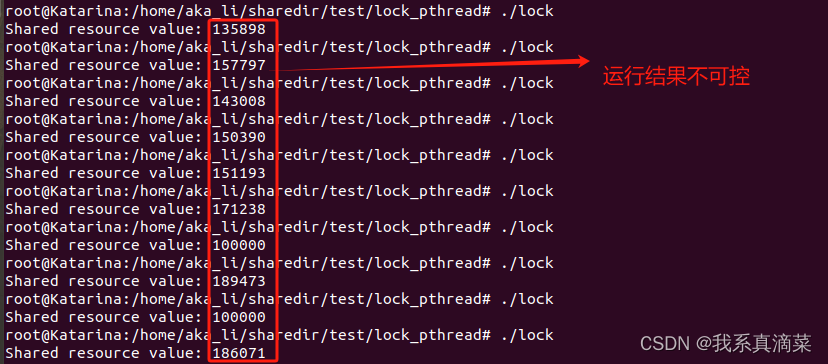1、概念
1.1 定义
互斥锁(Mutex),又称互斥型信号量,是一种特殊的二值性信号量,主要用于实现对共享资源的独占式处理。任意时刻,互斥锁的状态只有两种:开锁或闭锁。当有任务持有时,互斥锁处于闭锁状态,这个任务获得该互斥锁的所有权;当该任务释放它时,互斥锁被开锁,任务失去所有权。在一个任务持有互斥锁时,其他任务将不能再对该互斥锁进行开锁或持有。
1.2 应用场景
- 保护共享资源:最常见的应用场景是保护共享资源,确保多个线程不会同时访问共享资源而导致数据竞争和不一致性。
- 临界区保护:在多线程环境下,需要保护临界区(一段代码或数据结构)不被多个线程同时访问,互斥锁可以用来实现临界区的保护。
- 线程同步:互斥锁也可以用于线程之间的同步,确保线程按照一定的顺序访问共享资源,避免竞争条件和死锁。
2、常用接口
2.1 pthread_mutex_init
初始化互斥锁对象。
int pthread_mutex_init(pthread_mutex_t *mutex, const pthread_mutexattr_t *attr);- 入参:
- mutex:指向互斥锁对象的指针。
- attr:指向互斥锁属性对象的指针,通常传入NULL。
- 返回值:若成功,返回0;否则返回错误码。
2.2 pthread_mutex_lock
加锁,尝试获取互斥锁。
int pthread_mutex_lock(pthread_mutex_t *mutex);- 入参:
- mutex:指向互斥锁对象的指针。
- 返回值:若成功,返回0;否则返回错误码。
2.3 pthread_mutex_unlock
解锁,释放互斥锁。
int pthread_mutex_unlock(pthread_mutex_t *mutex);- 入参:
- mutex:指向互斥锁对象的指针。
- 返回值:若成功,返回0;否则返回错误码。
2.4 pthread_mutex_destroy
销毁互斥锁对象。
- 入参:
- mutex:指向互斥锁对象的指针。
- 返回值:若成功,返回0;否则返回错误码。
3、编程测试
示例中,定义了一个全局共享变量shared_resource,两个线程都会对这个变量进行增加操作。我们使用pthread_mutex_t类型的变量mutex作为互斥锁。在thread_function函数中,线程首先使用pthread_mutex_lock函数获取互斥锁,然后执行对共享资源的访问操作,最后使用pthread_mutex_unlock函数释放互斥锁。这样,当一个线程持有锁时,其他线程将无法获取锁,从而确保了同一时间只有一个线程能够访问共享资源。
在main函数中,我们首先使用pthread_mutex_init函数初始化互斥锁,然后创建两个线程。我们使用pthread_create函数创建线程,并将thread_function作为线程函数。接着,我们使用pthread_join函数等待线程结束。最后,我们使用pthread_mutex_destroy函数销毁互斥锁,并输出共享资源的最终值。
当不使用互斥锁的时候代码如下:
#include <stdio.h>
#include <stdlib.h>
#include <pthread.h> // 全局共享变量
int shared_resource = 0; // 互斥锁
pthread_mutex_t mutex; // 线程函数
void* thread_function(void* arg)
{ // 锁定互斥锁 // pthread_mutex_lock(&mutex); // 访问共享资源 for (int i = 0; i < 100000; i++) { shared_resource++; } // 解锁互斥锁 // pthread_mutex_unlock(&mutex); return NULL;
} int main() { // 初始化互斥锁 if (pthread_mutex_init(&mutex, NULL) != 0) { printf("Mutex initialization failed\n"); return 1; } // 创建两个线程 pthread_t thread1, thread2; if (pthread_create(&thread1, NULL, thread_function, NULL) != 0) { printf("Thread 1 creation failed\n"); return 1; } if (pthread_create(&thread2, NULL, thread_function, NULL) != 0) { printf("Thread 2 creation failed\n"); return 1; } // 等待线程结束 pthread_join(thread1, NULL); pthread_join(thread2, NULL); // 销毁互斥锁 pthread_mutex_destroy(&mutex); // 输出共享资源的最终值 printf("Shared resource value: %d\n", shared_resource); return 0;
}
测试发现两个线程访问同一个变量造成结果不可控:

放开代码中关于互斥锁的注释,测试代码如下:
#include <stdio.h>
#include <stdlib.h>
#include <pthread.h> // 全局共享变量
int shared_resource = 0; // 互斥锁
pthread_mutex_t mutex; // 线程函数
void* thread_function(void* arg)
{ // 锁定互斥锁 pthread_mutex_lock(&mutex); // 访问共享资源 for (int i = 0; i < 100000; i++) { shared_resource++; } // 解锁互斥锁 pthread_mutex_unlock(&mutex); return NULL;
} int main() { // 初始化互斥锁 if (pthread_mutex_init(&mutex, NULL) != 0) { printf("Mutex initialization failed\n"); return 1; } // 创建两个线程 pthread_t thread1, thread2; if (pthread_create(&thread1, NULL, thread_function, NULL) != 0) { printf("Thread 1 creation failed\n"); return 1; } if (pthread_create(&thread2, NULL, thread_function, NULL) != 0) { printf("Thread 2 creation failed\n"); return 1; } // 等待线程结束 pthread_join(thread1, NULL); pthread_join(thread2, NULL); // 销毁互斥锁 pthread_mutex_destroy(&mutex); // 输出共享资源的最终值 printf("Shared resource value: %d\n", shared_resource); return 0;
}
测试结果如下,实现对变量的保护:

4、总结
本文讲解了linux线程同步中使用的互斥锁的概念的定义和应用场景,列举了常用的编程接口,并编写测试用例进行测试。

















)

